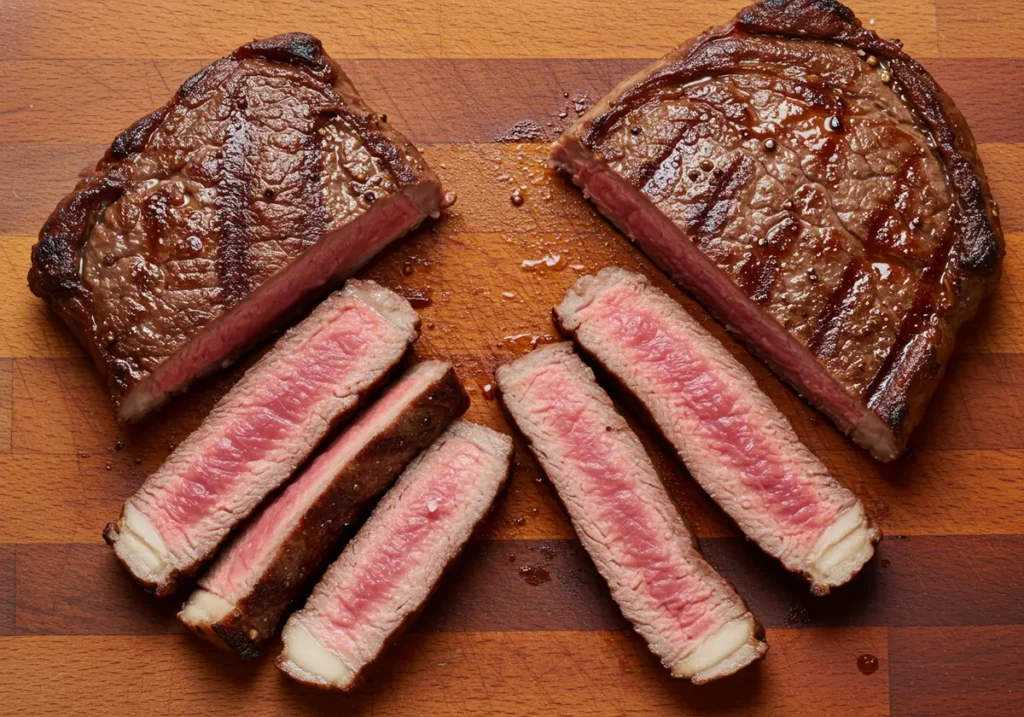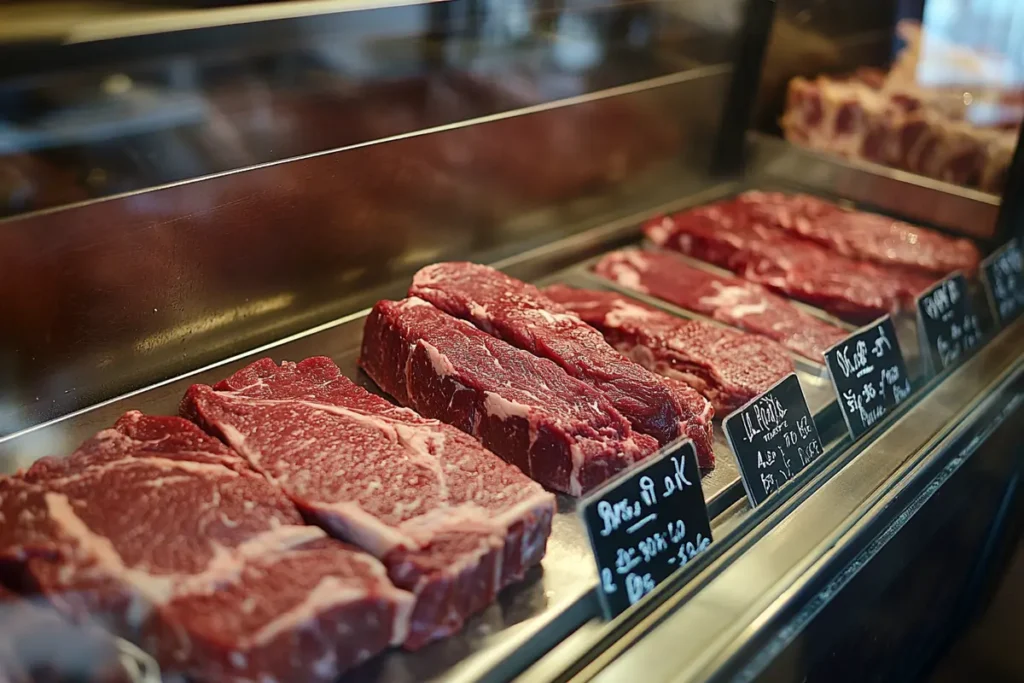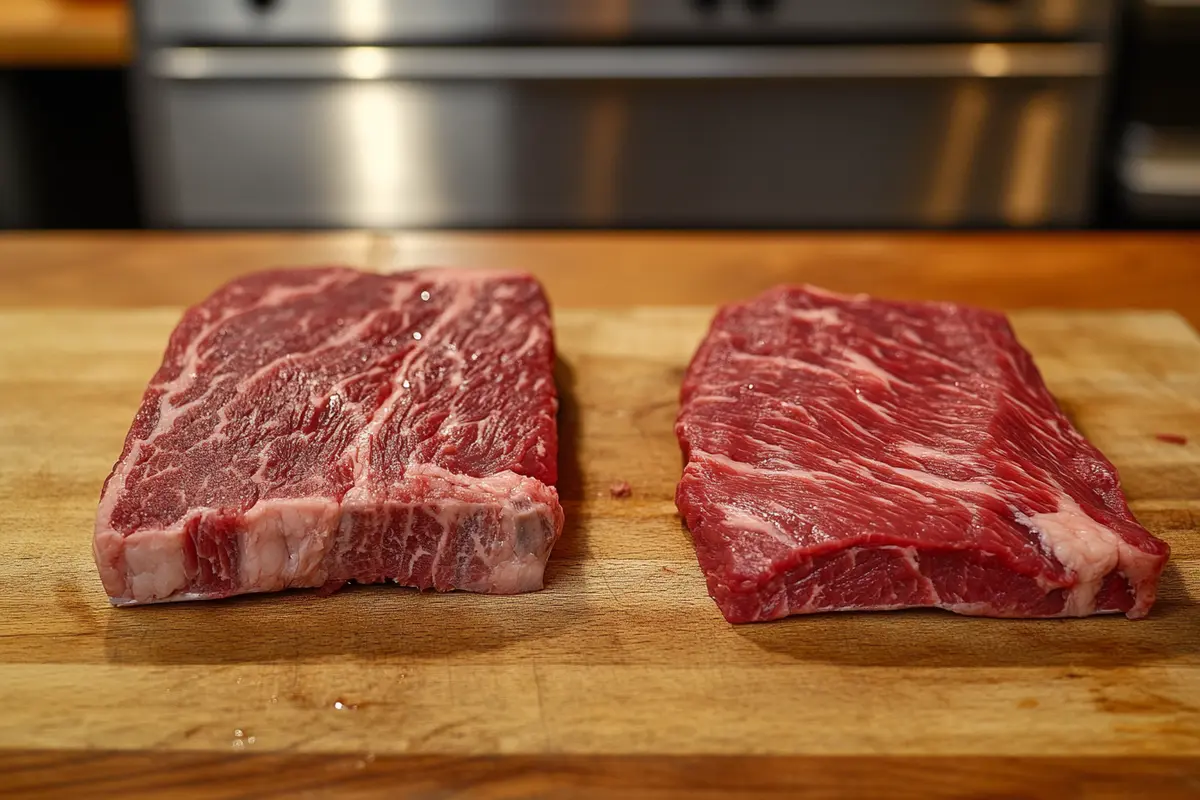Walk into any butcher shop or scroll through a meat delivery site, and you’ll likely run into two cuts that look surprisingly alike: hanger steak and skirt steak. Both are long, thin cuts with rich marbling, loose grain, and a reputation for big flavor. But don’t let looks fool you—these steaks aren’t identical.
In the ultimate beef face-off—hanger steak vs skirt steak—the differences matter. From tenderness and texture to prep time and price, each cut brings something unique to the table. So, how do you choose between them?
In this guide, we’ll break down exactly how these two cuts compare:
- Where do they come from on the cow
- Their differences in flavor, chew, and grain
- Which one performs better on the grill or in fajitas
- What to ask your butcher (so you get the real thing)
Whether you’re a backyard grill master or just steak-curious, this hanger steak vs skirt steak guide will help you decide which cut belongs in your kitchen.
Location & Anatomy Differences
To understand the difference between hanger steak vs skirt steak, you have to start with the anatomy. While both cuts come from the plate section (near the belly), they serve different structural purposes in the cow, and that affects everything from texture to tenderness.
Where Each Cut Comes From
- Hanger steak is a “hanging” muscle located inside the ribcage, suspended between the last rib and the loin. Each cow only has one hanger steak, making it a rare cut.
- Skirt steak comes from the diaphragm muscle. There are two skirt steaks per animal—an inside and an outside skirt—so it’s more common and often cheaper.
Although they both live in the plate section, they’re distinctly different muscles with different uses in the animal’s body.
Grain Structure & Muscle Fiber
Hanger steak has a looser grain with finer muscle fibers, making it naturally more tender (if prepped properly). Skirt steak has a more pronounced grain, and its fibers are longer and more defined, contributing to a chewier bite, especially if overcooked or sliced incorrectly.
Grain direction matters. Both cuts need to be sliced against the grain, but skirt steak is especially unforgiving if you skip this step.
Size & Shape Differences
- Hanger steak: Thicker, shorter, and often split into two lobes by a central membrane (must be removed).
- Skirt steak: Long, flat, and fairly uniform in shape—perfect for quick searing or stuffing.
These differences also affect prep, which we’ll dive into more in Part 3. But the takeaway here is simple: in the anatomy of hanger steak vs skirt steak, the hanger is rarer and naturally more tender, while skirt is longer, leaner, and more widely available.
Still unsure what makes hanger steak unique? Here’s a full breakdown of what hanger steak is and why it matters.
In summary, understanding the hanger steak vs skirt steak distinction starts at the source—the cow’s anatomy—and ends on your plate.
Flavor & Texture Showdown
When it comes to flavor and mouthfeel, the battle of hanger steak vs skirt steak is tighter than you might think. Both offer that bold, beef-forward taste that steak lovers crave, but each delivers it in a slightly different way.

Flavor Profiles: Rich vs Robust
- Hanger steak is often called the “butcher’s steak” for a reason: it packs intense, deep umami flavor without needing much seasoning. It’s tender, juicy, and almost creamy when cooked to medium-rare.
- Skirt steak, on the other hand, has a strong, beefy punch that holds up to bold marinades and spicy rubs. It’s slightly less refined, but full of character—perfect for dishes like fajitas or tacos.
Both cuts soak up flavor well, but the looser grain of hanger steak allows it to absorb marinades faster, making prep time more flexible.
Texture & Tenderness Breakdown
One of the key factors in the hanger steak vs skirt steak debate is texture. Skirt steak is famously chewy, with a long muscle structure that requires careful slicing. It’s not tough per se—but if you overcook it or slice it wrong, it quickly loses its appeal.
Hanger steak, however, is more forgiving. The finer grain and slightly higher fat content give it a naturally tender feel, especially when cooked hot and fast, then rested properly.
| Feature | Hanger Steak | Skirt Steak |
|---|---|---|
| Texture | Tender, rich | Chewy, fibrous |
| Grain | Loose, open | Long, defined |
| Marinate Time | Short (30–60 mins) | Medium (2–4 hours) |
| Fat Content | Slightly higher | Leaner |
Want to elevate the flavor of either cut? Check out our top marinades for hanger steak.
When Texture Matters Most
If you’re after tenderness, hanger steak wins with minimal effort. But if you’re grilling for tacos, stir-fries, or want that signature chew in each bite, skirt steak delivers the goods—just prep it right.
Either way, flavor is bold and beefy. It comes down to how you want that flavor delivered: with a silky, melt-in-your-mouth finish or a firmer, toothsome chew.
Cooking Methods & Performance
One of the most practical differences in the hanger steak vs skirt steak debate comes down to how they behave in the pan or on the grill. While they may look similar, they respond differently to heat, prep, and timing. Knowing how to cook each dish the right way helps avoid chewy bites and flavor loss.
Ideal Cooking Techniques
Both cuts shine with high-heat, fast-cook methods like:
- Grilling
- Pan-searing
- Broiling
- Sous-vide (followed by a hot sear)
Skirt steak cooks slightly faster due to its thinness, while hanger steak needs a bit more time because of its thicker center and denser interior muscle.

Trimming & Prep Time
One big difference in hanger steak vs skirt steak prep is trimming.
- Hanger steak usually has a thick membrane running down the center. If not pre-trimmed, you’ll need to remove it before cooking. This adds 5–10 minutes of prep.
- Skirt steak often comes ready to go—just remove excess fat or silverskin, then season and cook.
This prep difference can be a dealbreaker if you’re short on time. But if you’re after tenderness, the extra effort for hanger is worth it.
Cooking Time & Internal Temp Guide
| Cut | Thickness | Cook Time (med-rare) | Internal Temp |
|---|---|---|---|
| Hanger Steak | ¾–1 inch | 4–5 min per side | 125–130°F |
| Skirt Steak | ½ inch or less | 2–3 min per side | 125–130°F |
For best results, use a meat thermometer and don’t go past medium. Both cuts lose tenderness if overcooked.
Resting & Slicing Tips
Always rest the steak for 5–10 minutes before slicing to retain juices. Then slice against the grain:
- Hanger steak: grain runs lengthwise, easier to read
- Skirt steak: grain is more obvious but often curved—cut perpendicular to the lines
Want the ultimate sear and char? Here’s how to grill hanger steak to perfection.
Key Cooking Takeaways
| Category | Hanger Steak | Skirt Steak |
|---|---|---|
| Prep Time | Medium (requires trimming) | Low |
| Cook Time | Slightly longer | Very fast |
| Forgiveness | More forgiving | Less forgiving |
| Best Method | Sear or grill | High heat, short cook |
In the hanger steak vs skirt steak cooking showdown, hanger takes the lead for tenderness, but skirt wins for speed. Your choice depends on how much effort you want to put in before dinner.
Cost, Availability & Butcher Notes
Let’s talk access and affordability. One of the biggest considerations in the hanger steak vs skirt steak matchup is cost and availability. Even if you’ve picked your favorite based on flavor or tenderness, it doesn’t matter much if your local store never carries it.
Availability at the Butcher
- Hanger steak is a specialty cut. Each cow only yields one hanger, so it’s harder to come by. Many grocery stores don’t carry it unless it’s a high-end butcher or specialty meat market.
- Skirt steak is far more common. It’s used widely in Latin cuisine and shows up regularly in supermarkets, butcher shops, and bulk meat boxes.
Depending on where you live, skirt steak might be your only option—and that’s perfectly fine if you know how to prep and slice it right.

Price Per Pound
Because of its rarity, hanger steak often costs a bit more:
| Cut | Average Price/lb | Availability |
|---|---|---|
| Hanger Steak | $14–$22 | Moderate to Low |
| Skirt Steak | $10–$17 | High |
Note: Prices vary based on grade, trim, and whether it’s grass-fed or grain-finished.
You’ll also want to factor in waste: hanger steak often includes a center membrane that must be removed. If it’s not pre-trimmed, you’ll lose some weight during prep.
Need help trimming hanger steak? Check out our full guide on how to prepare hanger steak.
Butcher Label Confusion
Another wrinkle in the hanger steak vs skirt steak battle is naming confusion:
- Hanger steak may be mislabeled as “hanging tender,” “onglet” (in French), or even “butcher’s cut.”
- Skirt steak is sold as inside skirt or outside skirt, and the outside variety is more prized for tenderness
If you’re not sure what you’re buying, ask your butcher directly. Tell them how you plan to cook it and what texture you’re looking for—they’ll point you in the right direction.
Insider Tip: Grab It When You See It
Hanger steak isn’t just limited—it’s also in high demand with chefs and seasoned home cooks. If your store stocks it, grab extra and freeze some. When trimmed and wrapped well, hanger steak holds up great in the freezer.
In the hanger steak vs skirt steak price and availability category, skirt is the more accessible, affordable, and flexible option. But if you’re aiming for steakhouse flavor at home and spot hanger steak on the shelf—go for it.
Which One’s Right for You? + Comparison Table
Now that we’ve broken down every aspect of hanger steak vs skirt steak, it’s time to choose. While both cuts deliver serious flavor, the right one for you depends on your needs, preferences, and cooking style.
Choose Hanger Steak If You Want…
- A naturally tender cut with a buttery texture
- Minimal seasoning required for deep flavor
- A cut that impresses at dinner parties
- You don’t mind a bit of prep (trimming the membrane)
Ideal for: date-night steaks, bistro-style meals, pan-searing
Choose Skirt Steak If You Want…
- That big, beefy bite perfect for tacos or fajitas
- A thinner cut that cooks very quickly
- Easier prep, with little to no trimming
- A more affordable, everyday option
Ideal for: grilling, stir-fries, family meals
Hanger Steak vs Skirt Steak Comparison Table
| Feature | Hanger Steak | Skirt Steak |
|---|---|---|
| Tenderness | More tender | Chewier, fibrous |
| Flavor | Deep, rich umami | Bold, beefy |
| Prep Time | Medium (trim membrane) | Low |
| Cook Time | 4–5 min per side | 2–3 min per side |
| Best Use | Steaks, bistro meals | Fajitas, tacos, stir-fries |
| Availability | Less common | Widely available |
| Price | Higher ($14–$22/lb) | Lower ($10–$17/lb) |
Still unsure? Try both and see which works better for your taste. Either way, you’ll walk away with a steak worth savoring.
Already cooking one of these cuts? Here’s how to cook hanger steak for restaurant-quality results.
Final Verdict
If tenderness is your top priority, hanger steak wins the crown. But if you’re looking for bold, versatile, budget-friendly beef, skirt steak delivers every time.
In the end, the hanger steak vs skirt steak decision comes down to your cooking goals. For steakhouse vibes, go hanger. For weeknight flavor bombs? Skirt has your back.

